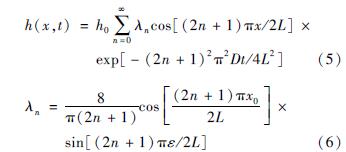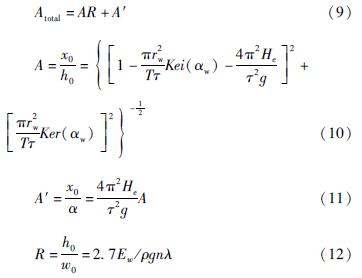基金项目:国家重点研发计划(2020YFA0710600)资助.
(1.北京大学 地球与空间科学学院,北京 100871; 2.河北红山巨厚沉积与地震灾害国家野外科学观测研究站,北京 100871)
(1.School of Earth and Space Sciences,Peking University,Beijing 100871,China)(2.Hebei Hongshan National Observatory on Thick Sediments and Seismic Hazards,Beijing 100871,China)
well water level; coseismic response; step-like changes; sustained changes; water level oscillation
DOI: 10.20015/j.cnki.ISSN1000-0666.2022.0052
备注
基金项目:国家重点研发计划(2020YFA0710600)资助.
引言
大地震可以在很大范围内引发各种各样的水文地质现象,比如溪水流量的变化、井水位变化以及土壤液化等现象(Wang,Manga,2021)。地下水的同震响应可以出现在距离震中几百千米的范围内,而且同震响应变化幅度也比较大,响应范围和变化幅度是采用传统的水文研究方式如抽水、注水等所不能达到的,所以地下水同震响应为研究影响地下水流动的相关物理因素和机制提供了良好的条件。早在2000年前一些学者就注意到了震后的水文地质现象,直到20世纪晚期,随着水位观测仪器不断改进,地下水位观测积累了更多、更精确的数据,记录到了更多地震引起的地下水位变化,从而促进了对地震与地下水相互作用的认识。地震发生后产生的静应变和动应变可以改变含水层的孔隙压力及其水文地质性质(如渗透率),从而引起水流变化。但有些地震引起的水文现象距离发震断层很远或者水位变化的幅度过大,无法用同震应力改变来解释,需要寻求其它的机制。
井水位的同震变化主要研究震后井水位变化,即多井对同一个地震的响应和同一水井对多个地震的响应。多井对同一地震响应的研究侧重于同震水文响应的区域变化,得到地质或水文特性对地震响应的影响(Wang,Manga,2021),例如1999年中国台湾集集MW7.5地震的水位响应研究(Wang et al,2001)。同一水井对多个地震响应的研究便于排除井周围岩石水文地质性质的影响,强调地震因素对水位的影响,例如Roeloffs(1998)在美国加州帕克菲尔德处一口水井内观测到的对多个区域地震的同震井水位变化。20世纪70年代至今,人们致力于研究井水位对地震响应的机制,最初发现了井水位与板块应变间的关系(Wakita,1975; Roeloffs,Bredehoeft,1985; Igarashi,Wakita,1991),后续又发现地震改变渗透率从而造成井水位变化等机制(Roeloffs,1998; King et al,1999; Brodsky,2003; Elkhoury et al,2006; Liu,Manga,2009; Lai et al,2021; Wang,2022)。此外,国内有非常丰富的水井观测资料,这为井水位同震响应研究、探究同震水位变化机理奠定了良好的基础(Shi et al,2014,2015a,b; Shi,Wang,2015; Yan et al,2014; Zhang et al,2019; Lai et al,2021)。本文将综合论述井水位同震响应的观测现象及其相关机制,总结引起井水位变化的物理过程,最后论述了地下水响应与地震能量之间的关系。
1 井水位同震响应特征
1.1 井水位同震阶跃变化特征地震发生后,近场(几个主震断层长度范围内)的井水位同震响应类型主要为阶跃变化(图1a、b),即阶跃上升或下降,最大的变化可达10 m
(Chia et al,2001)。水位阶跃变化在空间上通常与同震静态应变场相关,井水位在体应变压缩区上升,在体应变扩张区下降(Wakita,1975; Jonsson et al,2003)。但是,井水位的阶跃变化也有与应变不相符的现象(Quily,Roeloffs,1997; Wang et al,2001; Yan et al,2014,2014; Shi et al,2015a; Hosono et al,2019)。例如,1999年中国台湾集集MW7.5地震同震破裂以逆冲为主,但在主断层附近出现井水位下降、在同震应力拉张区出现井水位阶跃上升(图1c)(Wang et al,2001); 2008年我国境内大范围井水位对汶川地震的响应,只有小部分的同震变化可以用静态应力来解释(Shi et al,2015a)。
1.2 井水位同震持续变化特征井水位同震的持续变化是指井水位同震变化需要时间,区别于快速的阶跃性变化,这里强调
图1 1999年中国台湾集集地震同震井水位阶跃上升(a)和阶跃下降(b),集集地震附近地形图和液化区域、井水位变化分布及震源机制解(c)(修改自Wang et al,2001)
Fig.1 The coseismic step-like rise of the water level(a),the coseismic step-like drop of the water level(b) during the 1999 Chi-Chi earthquake,and the topographic map,the liquefaction area,variation of water levelthe in the well and the focal mechanism of the Chi-Chi earthquake(c)(modified from Wang et al,2001)其是由同震过程引起,但响应需要一定的时间,区别于震后同震孔隙压改变恢复到震前水平的过程。这种持续性变化可以发生在发震断层近场、中场(几个主震断层长度以外10个主震断层长度内)及远场(10个主震断层长度外)。一般井水位同震持续变化有两种主要类型。第一类是震后几天或几周内井水位持续上升或者下降,例如,Roeloffs(1998)在美国加州帕克菲尔德一口水井内观测到的多个区域地震影响的井水位变化(图2a~e)。该持续性的井水位变化与同震震源机制无关,即无论是什么类型地震,同一口井的井水位变化都表现为持续上升或持续下降。虽然持续水位变化的大小不一样,但是正则化之后的水位变化都是一样的(图2f)。持续变化的井水位能否恢复到震前水平,和造成其现象的机制有关。在近场观测中,该类持续性变化容易被井水位阶跃变化所覆盖,故不容易被观测到,但多在中场被观测到。第二类是井水位随地震波震荡后短时间内出现持续上升或下降,Brodsky(2003)在美国俄勒冈一处水井中发现地震波之后水位发生明显的持续变化(图3),且没有恢复到之前的值(图3),这种现象在地震远场比较常见。有的时候,由于井水位观测的采样率不够高,短时间的持续水位变化表现为阶跃变化。这两类持续性的井水位同震变化强调了水位变化需要时间,而这个变化时间取决于水井离扰动源的距离。第二类地震波后的井水位快速变化,由于水位对地震波震荡响应的干扰,比较难分辨该变化是持续变化还是瞬时阶跃变化。我们这里将其归类为同震井水位持续性变化,强调该井水位变化需要一定的时间,区别于孔隙压对应变响应引起的阶跃水位变化。
图2 美国加州帕克菲尔德附近一口水井对不同区域地震响应的同震井水位变化(a~e)及正则化后该井水位的同震变化(f)(修改自Roeloffs,1998)
Fig.2 The coseismic responses of the water level in a well near Parkfield to the regional earthquakes(a~e),and normalized coseismic water-level responses(f)(modified from Roeloffs,1998)图3 美国俄勒冈州一口水井对1999年墨西哥瓦哈卡MW7.4地震的同震水位响应(剔除了潮汐、气压响应以及线性趋势)(a)及附近地震台站记录的垂向地面速度(b)(修改自Brodsky et al,2003)
Fig.3 Coseismic water-level changes in a well in Oregon, USA during the Oaxaca,Mexico MW7.4 earthquake(a),the vertical ground velocity recorded by the eartquake stations in the vicinity(b)(modified from Brodsky et al,2003)1.3 井水位同震震荡变化特征地震波造成的地下水震荡被称为“水震图”,是最早被发现的地下水对地震响应的现象之一(Byerly,Blanchard,1935)。地下水震荡现象可以在地震近场、中场和远场发生,但是井水位的震荡观测取决于水位计的采样率,如果没有高频观测(>1 Hz),则很难观测到,而地震远场由于没有同震形变的影响,更容易观测到井水位的震荡变化。多数情况下,井水位对地震瑞利波最敏感,尤其是周期为十几至二十几秒的信号,该情况下井水位震荡通常与地面垂向运动最符合(图4)。但在某些少数情况下,也观测到了井水位对剪切波S波、勒夫波以及P波的响应(Wang et al,2009; Shalev et al,2016a)。
图4 2002年美国迪纳利MW7.9地震引起的俄勒冈州一处水井的水位变化(a)以及地震波的径向(b)、横向(c)和垂向(d)的地面速度(修改自Brodsky,2003)。
Fig.4 Water level oscillation(a)and seismic radial(b),transverse(c)and vertical(d)ground velocity in Oregon,USA during the 2002 Denali MW7.9 earthquake(modified from Brodsky,2003)上述3种井水位同震变化不是完全区分的,在合适的距离以及高采样率的观测下可以捕捉到多种响应的结合(Shi et al,2015a)(图5)。但是井水位同震变化的观测,往往与水位计的采样频率相关。当仪器采样频率不够高时,无法捕捉到井水位的震荡现象,而且持续变化过程容易被观测成阶跃变化。
图5 2008年汶川MW7.9地震造成的中国大陆内9口井不同的水位同震响应模式(修改自Shi et al,2015a)
Fig.5 Nine distinct response patterns of water-level changes induced by the Wenchuan MW7.9 earthquake in 2008(modified from Shi et al,2015a)2 井水位同震响应机制
2.1 同震井水位阶跃变化机制不排水条件下,孔隙压对地震产生的静态应力的响应是地震近场水位阶跃变化的主要机制之一。因此,大多数情况下,近场井水位阶跃变化,和同震应力场相符。同震破裂过程非常短,所以可以近似成不排水条件下孔隙压对同震静态应力的响应,其表达式为(Wang,2000):
P=-B(σii)/3(1)
式中:P为孔隙压; B是Skempton系数; σii/3是平均主应力,当平均主应力为拉张时,孔隙压下降,井水位阶跃下降; 平均主应力为压缩时,井水位阶跃上升。
不排水条件下,井水位对同震静态应变的响应是最早提出的地震引起地下水流变化的机制之一(Wakita,1975)。一些学者根据断层同震滑动模型计算由同震位错引起的应力场,然后用同震应力场解释井水位同震阶跃变化(Wakita,1975; Igarashi,Wakita,1991; Quilty,Roeloffs,1997; Koizumi et al,2004)。Quilty和Roeloffs(1997)根据1994年12月20日美国帕克菲尔德附近M4.7地震的同震模型计算体应变,发现主震附近大部分井水位变化幅度都与体应变大小成比例。此外,同震应变场可以通过合成孔径雷达干涉(InSAR)和全球定位系统(GPS)获得,可直接用其验证井水位阶跃变化是否是由同震应变引起的(图6)(Jonsson et al,2003; Akita,Matsumoto,2004)。如果有应变仪记录到同震应变,也可以通过记录的同震应变大小来推知同震水位变化。但在分析同震体应变时,需要区分观测到的应变是由同震形变引起的,还是由水位变化造成的。Wang和Barbour(2017)发现了浅层地壳孔隙压力变化对同震体应变的影响。Zhang等(2017)也发现了地震远场记录的同震应变变化不是由地震造成的,而是与同震改变的水位变化相关。由于同震井水位变化和同震应力之间存在线性关系,因此也可以通过近场同震阶跃井水位变化推知近场的同震应力变化。Igarashi和Wakita(1991)利用井水位对潮汐的响应得到应变敏感度,然后结合井水位的同震阶跃变化估算出对应的同震应变量,将结果与均匀半空间粘弹性断层模型预测的同震应变量对比,发现更深水井的结果与预测模型更加符合,可能是由于均匀半空间的粘弹性模型简化了浅层地表的复杂情况。
图6 2000年6月21日MW6.5走滑地震的同震井水位变化和由同震体应变计算的不排水条件下孔隙压力变化(修改自Jonsson et al,2003)
Fig.6 Coseismic groundwater level changes(circles)and the predicted undrained pore-pressure changes caused by coseismic volumetric strain change(color map)during the June 21,2000 MW6.5 strike- slip earthquake(modified from Jonsson et al,2003)造成井水位同震阶跃变化的主要机制还有非排水固结和液化,该情况下引起的水位变化总是上升,且与同震应变分布并不符合。例如,1999年中国台湾集集地震同震破裂以逆冲为主,但是在同震应力拉张区出现井水位阶跃上升,并且在该区域观察到液化现象(图1c)(Wang et al,2003,2005)。Wang等(2001)提出用非排水岩土固结和液化机制来解释该现象,在没有固结的沉积物中,由地震波振动造成的偏应力循环加载会造成沉积物颗粒趋向密实,从而造成孔隙体积的减小,使得孔隙压上升,水位上升。由于该过程发生时间短,所以处于不排水状态,高孔隙压使得岩土沉积物的剪切阻力降为零从而出现液化现象。所以在液化区,总是可以观测到井水位的上升,其变化和同震静态应力场不吻合。液化现象需要的最小能量为0.1 J/m3(Wang,2007)。
地震对含水裂隙产生的挤压或拉张也可以造成同震井水位的阶跃上升或下降(Muirwood,King,1993)。对于正断层,震间断层周围的裂隙处于拉张状态,同震挤压这些拉张的裂隙,从而使水从裂隙排出,造成地下水上升。对于逆断层,震间断层周围的裂隙处于挤压状态,同震拉张这些挤压的裂隙,使水可以填充裂隙,造成水位下降(图7)。除此之外,地下水可以随地震产生的裂缝迁移,出现阶跃水位下降。King等(1999)发现地震震动在含水层和断裂带间产生相互连通的缝隙,使水快速从高压区流向低压区,从而造成水位阶跃变化。Hosono等(2019)观测到2016年日本熊本MW7.0地震后主断层附近的水位出现阶跃下降,并提出该水位下降由地下水沿着地震产生的裂隙运移造成。
地震也可以通过对地表浅部的毛细水带和包气带产生震动将水释放出来,形成水位阶跃上升(Mohr et al,2015; Breen et al,2020)。2010年智利毛莱MW8.8地震造成了溪流流量的增加,Mohr等(2015)提出水从包气带释放从而引起水位上升。Breen等(2020)在实验室里验证了该机制,其观测到了由于震动破坏毛细力,水从毛细层和不饱和层释放出的现象。该机制与土壤液化引发的水位阶跃的上升时间不同,实验室里不饱和层和毛细层在震动后的水压上升时间比饱和带水压上升时间短,但是这需要非常高的观测采样才能进行分辨。野外的观测一般不高于1 Hz,所以比较难从野外观测上通过上升时间区分这两种机制。从不饱和层中将水震动出来所需能量的阈值是100 J/m3,高于液化所需要的能量阈值0.1 J/m3(Breen et al,2020),所以某些情况下可以通过能量区分这两种机制。
2.2 同震井水位持续性变化机制引起同震井水位缓慢持续变化的主要机制分别为:同震改变局部孔隙压引起水流渗流过程、同震流量变化以及同震渗透率改变。
地震可以引起局部孔隙压的改变,该孔隙压改变引发的水流流动可导致井水位的持续变化,模型如图8所示。假设在区域〖JB<1|〗x-x0〖JB>1|〗<ε,含水层孔隙压改变量为h0,固定的泄水区与补水区距离为L,泄水区处的孔隙压为0,井离补水区的距离为XL。该过程满足一维的渗流过程,可以表达为:

边界条件为:

初始条件为:

式中:D是水位传导系数,单位为m2/s; h是水头,单位为m; x是水平距离,单位为m。该方程对应的解是(Roeloffs,1998):

模型中,井水位变化需要的时间取决于水井与发生压力变化区域的距离XL-X0,井水位恢复的时间决定于井离排泄区的距离L-XL(Matsumoto,Roeloffs,2003)。该水位变化的特征时间由岩石的渗透率决定。
图8 局部孔隙压力改变的渗流过程简易模型(修改自Matsumoto,Roeloffs,2003)
Fig.8 Conceptual model of the diffusion of a localized coseismic pore pressure change(modified from Matsumoto,Roeloffs,2003)地震发生后,由于某种原因,改变了局部泄水区或补水区的流量,从而使得附近井水位出现缓慢持续变化(Roeloffs,1998)。如果局部的流量变化可以用点源来表示,那么观测井中水位变化可用Theis解表达(Freeze,Cherry,1979):

式中:H是含水层厚度,单位为m; r为水井距离流量改变区域的位置,单位为m; K渗透系数,单位为m/s。
公式(7)和抽水注水方程的解一样,水位变化是单调递增或者递减变化,没有井水位恢复到震前的过程。当局部水流流量变化不能用点源表示时,也可以用线源或面源的水流补给或排泄来解释,这种情况就是由地下水沿着地震新产生裂隙通道形成的水源补给或泄流造成(Wang et al,2001,2004)。1999年中国台湾集集MW7.5地震后山区溪流流量增加,并且在冲积扇区域也有溪流流量增加(Wang et al,2001)。这些增加的流量大部分都来源于山区,由在冲积扇的沉积物固结和液化不足造成。而在逆冲断层的山脚下有水位下降(图1c),并且有大量的次生垂直拉伸裂缝出现。因此,Wang等(2004)用线源补给的一维渗透模型,解释了震后溪流流量增加的水文现象。
地震还可以通过改变岩石渗透性来改变水位。根据达西定律:
Q=-AK(dh)/(dl)(8)
式中:Q为水流流量,单位为m3/s; A为横截面积,单位为m2; K为渗透系数,单位为m/s;(dh)/(dl)为水力梯度。
如果空间上存在水头变化,渗透性的改变可以改变水位,水位的增加或降低取决于井位于水流的上游还是下游(Liao et al,2021)。如果空间没有明显的水头变化,即使有渗透性的改变,也不容易观测到水位的变化。但是如果该水井对潮汐、大气压力或者季节水位变化的干扰比较敏感,那么渗透性的改变会影响井水位对这些干扰的响应,从而观察到井水位变化。但是该变化取决于地震发生时这些干扰源的变化情况,也就是水位即可出现上升也可出现下降。该机制不能解释同震井水位总是同方向变化的情况,而且没有水位恢复到震前的过程。
近场渗透性的改变主要是由于裂隙的产生(Wang et al,2004; Hosono et al,2019),远场渗透性的改变主要是由地震波引起的(Brodsky et al,2003; Elkhoury et al,2006)。地震波引起渗透性改变的主要机制分别为孔隙介质里颗粒运移(Brodsky et al,2003; Candela et al,2014)、孔隙介质里气泡的运移(Roeloffs,1998; Matsumoto et al,2003)和深部液化(Wang,2022)。当水位变化是由渗透性变化引起时,其大小及上升或下降都有一定的随机性,没有统一的规律(Yan et al,2014; Shi et al,2015a; Zhang et al,2015,2016; Lai et al,2021)。渗透率的改变会引起水位的变化,当渗透率恢复时,水位也可以恢复到震前水平。但是有时渗透率的改变会持续非常长的时间(几年),这时水位的改变就是持久性的,往往深部液化引起的渗透率改变会持续非常长的时间(Liao et al,2021; Zhang et al,2021; Wang,2022)。渗透性改变一般是通过水对天然周期源的响应变化来探测,例如井水位对潮汐、大气压和地震波的响应(Lai et al,2014; Zhang et al,2015,2019; Shi,Wang,2016; Sun et al,2019)。
地震波之后伴随的井水位持续性变化的主要机制分别为:地震波的震动产生的渗透性改变、岩石非弹性形变、气泡的运移等。
Brodsky(2003)提出了井周围岩石渗透率的提高引起局域不同孔隙压变化的连通导致地震波后的井水位产生持续变化,该过程可以用固定边界水压渗流的过程表示。水位变化的快慢取决于井与孔隙压改变区域的距离。井水位出现上升或下降变化,取决于连通处水压的变化。随着渗透性的恢复,井水位变化也会恢复到震前水平。
地震波在破碎岩石里产生的非弹性形变也可以造成井水位随地震波震荡后持续的上升或者下降。该过程井水位变化时间非常短,并且不能恢复到震前水平。Shalev等(2016b)在死海断层转换带两侧的两口水井中观测到了由2013年巴基斯坦俾路支省MW7.7地震产生的地震波导致的井水位持续性下降和上升(图9),并提出地震波的振动使岩石达到屈服状态,当体应变增加时,会产生压缩,从而使得孔隙压上升,井水位上升; 当偏应变增加时,更容易产生破坏,从而产生膨胀效应使得孔隙压下降,井水位下降。两口水井所呈现的不同表现是由岩石破坏程度不同造成的。对于破坏程度较高的岩石,偏应变作用为主导,岩石膨胀,水位降低; 对于破坏程度较低的岩石,体应变作用为主导,岩石压实,水位上升。
地震波之后的持续水位变化的另一个常见机制是地震波移除孔隙中的气泡或者震动使得气泡生长,但该过程不能解释同震井水位变化的恢复过程。Lai等(2021)观测到四川盆地荣昌气田井水位在2008年汶川MW7.9地震后出现快速下降,主要由孔隙里气泡释放造成。同时也观测到了地震波之后,井水位的上升,这是因为地震波的
图9 2013年巴基斯坦俾路支省MW7.7地震造成在死海断层转换带两侧的两口水井同震井水位持续下降和上升时径向、横向和垂向地面速度(a~c)及两口水井中记录的井水位变化(d)(修改自Shalev et al,2016b)
Fig.9 Seismograms and water-level responses to the 24 September,2013 MW7.7 Balochistan,Pakistan earthquake:Radial(a),transversal(b),and vertical(c)components and water-level changes(d)recorded at Gomè 1 and Meizar 1(modified from Shalev et al,2016b)振动也可以使介质中产生气泡,从而引起地下水位的上升,通常与地震面波造成的低频弱地面震动有关(Lai et al,2021)。
2.3 同震井水位震荡机制地震波对井水位造成的震荡主要是由地震波导致的孔隙压改变和地面垂向运动造成的,在水平延展均匀各向同性的含水层中,井水位对地震波的响应的理论解是(Cooper et al,1965):


式中: Atotal是井水位对地震波的总响应; A是井水位对由地震波造成含水层压力变化的响应; A'是井水位对由地震波造成地表垂向运动的响应; R是含水层压力变化与地面垂向位移的比值; x0为井水位震荡的振幅; h0为含水层压力水头扰动振幅; α为井-含水层系统垂向运动振幅; w0为地面垂向位移振幅; Ew为弹性体体积模量; ρ为含水层密度; n为含水层孔隙度; λ为瑞利波波长; rw为水井半径; T、S分别为含水层的导水系数、储水系数; τ为地震波周期; ω为地震波角频率; ɡ为重力加速度; H为井壳内水柱高度; d为含水层厚度; Kei和Ker为开尔文函数。
水位震荡对地震波的响应取决于水井尺寸、含水层水文性质(传导系数、储水系数、孔隙度)以及地震波类型、周期和振幅。图 10、11分别为由地震波造成含水层孔隙压力变化的井水位响应(式10)以及由地震波造成地表垂向运动的井水位响应(式11),图 12为地震波造成的总的井水位响应(式9)。由图 10可知,井水位对由地震波造成含水层孔隙压变化的响应不是单调变化的,该响应在井的共振频率时达到最大值。当地震波的振动频率小于井的共振频率时,响应随着地震波周期的变大而升高; 当地震波的振动频率大于井的共振频率时,响应随着地震波周期的变大而降低。共振频率由井孔内有效水柱高度决定,有效水柱高度与井孔内水柱高度和含水层厚度相关。总体上井水位变化对长周期地震波比短周期地震波的响应更敏感。井水位对地震波垂向运动的响应也呈现出类似的非单调变化(图 11)。但是该水位变化对短周期地震波的响应比长周期地震波响应更敏感。因瑞利波造成的含水层压力改变是造成的地面垂向运动的13~1 300倍(Cooper et al,1965),所以井水位对地震波的响应主要受到地震波改变孔隙压的响应。Kipp(1985)基于与Cooper等(1965)不同的动量平衡推导出一个震荡响应函数,并且合成了无量纲响应函数,可用于估计欠阻尼金属块或汲水实验的导水系数。Shapiro(1988)拓展了这些结果,使其可用于以裂缝为主的流动的含水层。Liu等(1989)通过完整分析水井在含水层中随深度变化的流量的准确形式修正了Cooper等(1965)的理论解,使理论解和观测的井水位地震波响应形式更加吻合。修正后的理论解更好地拟合了含水层开放段较长的井水位对
图 10 地震波造成含水层孔隙压力变化的井水位响应振幅
Fig.10 Amplification of pressure-head fluctuation of the aquifer of the well by seimic waves图 12 井水位对地震波总响应振幅,包括井水位对地震波造成孔隙压变化的响应和井水位对地面垂直运动的响应
Fig.12 The total response of water level in the well to seismic waves,including both water level amplification to pore pressure change caused by seismic waves and the response to vertical displacement due to seismic waves地震波的响应。当水井的开放段长度特别小的时候,这两个理论解非常接近。
地震波中瑞利波产生体应变最大,所以比较常观测到的是井水位对瑞利波的响应。但是井水位有的时候也可以观测到井水位对S地震和勒夫波的响应(Wang et al,2009; Shalev,2016a)。在均匀各向同性的介质里,孔隙压只对体应变有响应。但是当介质是各向异性或有裂隙存在的情况下,孔隙压会对偏应力产生响应(Skempton,1954),从而观测到井水位对S波和勒夫波的响应。
3 地下水响应与地震能量的关系
地震是否可以引起地下水的变化与地震在该处的能量相关。地震在地下水响应处的能量与水井震级和水井离震源的距离有关。Roeloffs(1998)通过分析不同地震引起水位变化的最远距离得到震级和可观测水位变化距离之间的经验关系式为:
M≥1.55+1.82log10D(15)
式中:M是震级; D是水井距震源的距离,单位为km。式(15)表示在给定距离范围内,可以引发地下水改变的最小地震震级。King等(1999)和Matsumoto等(2003)也根据其它观测结果给出了不同的最大响应距离关系式。这些关系式存在微小的不同,可能是由于观测数据有限或者研究区域不同水文地质条件造成。
Wang等(2006)得到了液化的极限距离与震级间的经验式,由此启发提出了地震引起水文现象的能量经验公式。通过地震能量密度、美国南加州的地震波衰减公式以及震级和能量之间的关系式,得到了地震能量密度e(单位:J·m-3)、震级(M)与水文现象距震源距离r(单位:km)的经验关系式(Wang,2007)为:
log10e=-3log10r+1.44M-4.62(16)
图 13是Wang和Manga(2021)收集的引起水文响应的震级与水文响应震中距的数据集,每条直线代表相同的地震能量密度。式(16)将实验室液化能量结果和野外同震水文响应观测结果联系起来。造成同震井水位变化的不同机制所需要的能量阈值不同,因此可以通过能量经验公式来约束同震水位变化的机制。另外,当水井附近没有地震波观测时,还可以利用式(16)得到地震在观测水井处的能量(Wang,2007)。但是由于地震波传播的复杂性,该经验公式得到的地震波能量与实际地震波的能量可能存在偏差。
4 结论
井水位同震变化主要有3种类型:阶跃型变化、持续型变化以及震荡变化。在地震近、中、远场中这3种变化类型都有可能发生,并且有可能同时存在。地震近场多观测到井水位的同震阶跃变化,中场多观测到持续性变化,远场多观测到震荡变化。观测的井水位变化类型还与观测仪器的采样率相关,当仪器采样频率不够高时,无法捕捉到井水位的震荡现象,而且持续变化过程容易被观测成阶跃变化。引起井水位同震变化的机制非常复杂,同震的静态应力场和地震波造成的动态应力场在近场和中场都有影响,且静态应力场起主导作用; 在远场则主要受地震波动态应力场的影响。近场井水位同震阶跃变化主要是由同震静态应力场、非排水岩土固结液化、地震对含水裂隙产生的挤压或拉张和地震对地表浅部的毛细水带和包气带产生震动将水释放出来造成。
本文将井水位同震的持续性变化分成了两类:一是缓慢长时间的持续性变化,二是随地震波振动后的快速持续变化。引起第一类持续变化的主要机制是局域孔隙压力改变引起水流变化、同震流量改变和渗透率改变; 引起第二类同震井水位持续变化的主要机制是渗透率改变、地震波造成的非弹性形变和地震波造成的气泡释放和生长。井水位同震震荡主要是由地震波对含水层孔隙压的改变以及垂向运动导致。其中地震波对孔隙压的改变起主导作用,所以井水位对长周期的地震波的响应更敏感。
同震水位变化是非常复杂的过程,类似的同震井水位变化,其机制可能不同。有些机制所需要的能量不同,所以可以通过水文响应和地震能量的经验公式,限定引起同震地下水响应的潜在机制。为了更好地约束同震井水位变化机制,可将震后更长的观测时间与更多的不同观测手段相结合,如温度、水化以及压力,以及提高观测的时间分辨率都将促进我们对同震地下水响应的物理机制的认识和发现。
-
Akita F,Matsumoto N.2004.Hydrological responses induced by the Tokachi-Oki earthquake in 2003 at hot spring wells in Hokkaido,Japan[J].Geophysical Research Letters,31(16):371-375.
- Blanchard F G,Byerly P.1935.A study of a well gauge as a seismograph[J].Bulletin of the Seismological Society of America,25(4):313-321.
- Breen S,Zhang Z,Wang C Y.2020.Shaking water out of sands:an experimental study[J].Water Resources Research,56(10):e2020WR028153.
- Brodsky E E.2003.A mechanism for sustained groundwater pressure changes induced by distant earthquakes[J].Journal of Geophysical Research,108(B8):2390.
- Byerly P,Blanchard F G.1935.Well gauges as seismographs[J].Nature,135(3408):303-304.
- Candela T,Brodsky E E,Marone C,et al.2014.Laboratory evidence for particle mobilization as a mechanism for permeability enhancement via dynamic stressing[J].Earth and Planetary Science Letters,392:279-291.
- Chia Y,Wang Y,Wu H,et al.2001.Changes of groundwater level due to the 1999 Chi-Chi earthquake in the Choshui River fan in Taiwan[J].Bulletin of the Seismological Society of America,91(5):1062-1068.
- Cooper H H,Bredehoeft J D,Papadopulos I S,et al.1965.The response of well-aquifer systems to seismic waves[J].Journal of Geophysical Research,70(16):3915-3926.
- Elkhoury J E,Brodsky E E,Agnew D C.2006.Seismic waves increase permeability[J].Nature,441(7097):1135-1138.
- Freeze R A,Cherry J A.1979.Groundwater[M].Englewood Cliffs,N.J:Prentice Hall.
- Hosono T,C Yamada,T Shibata,et al.2019.Coseismic groundwater drawdown along crustal ruptures during the 2016 MW7.0 Kumamoto earthquake[J].Water Resources Research,55(7):5891-5903.
- Igarashi G,Wakita H.1991.Tidal responses and earthquake-related changes in the water level of deep wells[J].Journal of Geophysical Research:Solid Earth,96(B3):4269-4278.
- Jonsson S,Segall P,Pedersen R,et al.2003.Post-earthquake ground movements correlated to pore-pressure transients[J].Nature,424(6945):179-183.
- King C Y,Azuma S,Igarashi G,et al.1999.Earthquake-related water-level changes at 16 closely clustered wells in Tono,central Japan[J].Journal of Geophysical Research:Solid Earth,104(B6):13073-13082.
- Kipp K L.1985.Type curve analysis of inertial effects in the response of a well to a slug test[J].Water Resources Research,21(9):1397-1408.
- Koizumi N,Lai W C,Kitagawa Y,et al.2004.Comment on “Coseismic hydrological changes associated with dislocation of the September 21,1999 Chichi earthquake,Taiwan” by Min Lee et al[J].Geophysical Research Letters,31(13):L13603.
- Lai G J,Lei X,Jiang C,et al.2021.Multiple mechanisms of coseismic water level changes at the Rongchang Well in a seismically active area in China[J].Tectonophysics,819:229083.
- Lai G J,Ge H K,Xue L,et al.2014.Tidal response variation and recovery following the Wenchuan earthquake from water level data of multiple wells in the nearfield[J].Tectonophysics,619-620(2014):115-122.
- Liao X,Wang G,Shi Z.2021.Sustained changes in well water levels following a large earthquake:possible evidence of permeability decreases in a shallow groundwater system[J].Geophysical Research Letters,48(1):e2020GL090232.
- Liu L,Roeloffs E,Zheng X.1989.Seismically induced water level fluctuations in the Wali Well,Beijing,China[J].Journal of Geophysical Research,94(B7):9453-9462.
- Liu W Q,Manga M.2009.Changes in permeability caused by dynamic stresses in fractured sandstone[J].Geophysical Research Letters:36(20):L20307.
- Matsumoto N,Roeloffs E A.2003.Hydrological response to earthquakes in the Haibara Well,central Japan; II,Possible mechanism inferred from time-varying hydraulic properties[J].Geophysical Journal International,155(3):899-913.
- Matsumoto,Norio,Kitagawa G,et al.2003.Hydrological response to earthquakes in the Haibara Well,Central Japan; I,Groundwater level changes revealed using state space decomposition of atmospheric pressure,rainfall and tidal responses[J].Geophysical Journal International,155(3):885-898.
- Mohr C H,Manga M,Wang C Y,et al.2015.Shaking water out of soil[J].Geology,43(3):207-210.
- Muirwood R,King.1993.Hydrological signatures of earthquake strain[J].Journal of Geophysical Research-Solid Earth,98(B12):22035-22068.
- Quilty E,Roeloffs E.1997.Water level changes in response to the December 20,1994,M4.7 earthquake near Parkfield California[J].Bulletin of the Seismological Society of America,87(2):310-317.
- Roeloffs E A,Bredehoeft J D.1985.Coseismic response of water wells near Parkfield,California,to the August 4,1985 North Kettleman Hills earthquake[J].Eos(Washington D C),66(46):986.
- Roeloffs E A.1998.Persistent water level changes in a well near Parkfield,California,due to local and distant earthquakes[J].Journal of Geophysical Research:Solid Earth,103(B1):869-889.
- Shalev E,Kurzon I,Doan M L,et al.2016a.Water-level oscillations caused by volumetric and deviatoric dynamic strains[J].Geophysical Journal International,204(2):841-851.
- Shalev E,Kurzon I,Doan M,et al.2016b.Sustained water level changes caused by damage and compaction induced by teleseismic earthquakes[J].Journal of Geophysical Research Solid Earth,121(7):4943-4954.
- Shapiro A M.1988.Interpretation of oscillatory water-level responses in observation wells during aquifer tests in fractured rock[J].Water Resources Resserch,25(10):2129-2137.
- Shi Z M,Wang G C,Wang C Y,et al.2014.Comparison of hydrological responses to the Wenchuan and Lushan earthquakes[J].Earth and Planetary Science Letters,391(2014):193-200.
- Shi Z M,Wang G C,Manga M,et al.2015a.Continental-scale water-level response to a large earthquake[J].Geofluids,15(1-2):310-320.
- Shi Z M,Wang G C,Manga M,et al.2015b.Mechanism of co-seismic water level change following four great earthquakes; insights from co-seismic responses throughout the Chinese mainland[J].Earth and Planetary Science Letters,430(2015):66-74.
- Shi Z M,Wang G C.2015.Sustained groundwater level changes and permeability variation in a fault zone following the 12 May 2008,MW7.9 Wenchuan earthquake[J].Hydrological Processes,29(12):2659-2667.
- Shi Z M,Wang G C.2016.Aquifers switched from confined to semiconfined by earthquakes[J].Geophysical Research Letters,43(21):11166-11172.
- Skempton A W.1954.The pore-pressure coefficients A and B[J].Geotechnique,4(4):143-147.
- Sun X L,Xiang Y,Shi Z M.2018.Estimating the hydraulic parameters of a confined aquifer based on the response of groundwater levels to seismic rayleigh waves[J].Geophysical Journal International,213(2):919-930.
- Sun X,Xiang Y,Shi Z.2019.Changes in permeability caused by two consecutive earthquakes-insights from the responses of a well-aquifer system to seismic waves[J].Geophysical Research Letters,46(17-18):10367-10374
- Wakita H.1975.Water wells as possible indicators of tectonic strain[J].Science,189(4202):553-555.
- Wang C H,Wang C Y,Kuo C H,et al.2005.Some isotopic and hydrological changes associated with the 1999 Chi-Chi Earthquake,Taiwan[J].The Island Arc,14(1):37-54.
- Wang C Y, Manga M, Manoochehr S, et al.2017.Induced seismicity in Oklahoma affects shallow Groundwater[J].Seismological Research Letters,88(4):956-962.
- Wang C Y,Barbour A J.2017.Influence of pore pressure change on coseismic volumetric strain[J].Earth Planet Sci Lett,475(2017):152-159
- Wang C Y,Cheng L H,Chin C V,et al.2001.Coseismic hydrologic response of an alluvial fan to the 1999 Chi-Chi earthquake,taiwan[J].Geology,29(9):831.
- Wang C Y,Chia Y,Wang P L,et al.2009.Role of S waves and Love waves in coseismic permeability enhancement[J].Geophysical Research Letters,36(9):L09404.
- Wang C Y,Dreger D S,Wang C H,et al.2003.Field relations among coseismic ground motion,water level change and liquefaction for the 1999 Chi-Chi(MW=7.5)earthquake,Taiwan[J].Geophysical Research Letters,30(17).
- Wang C Y,Manga M.2021.Water and earthquake[M].Cham,Switzerland:Springer Nature Switzerland AG.
- Wang C Y,Wang C H,Manga M.2004.Coseismic release of water from mountains; evidence from the 1999(MW=7.5)Chi-Chi,Taiwan,Earthquake[J].Geology,32(9):769-772.
- Wang C Y,Wong A,Dreger D S,et al.2006.Liquefaction limit during earthquakes and underground explosions—implications on ground-motion attenuation[J].Bulletin of the Seismological Society of America,96(1):355-363.
- Wang C Y,Zhu A Y,Liao X,et al.2019.Capillary effects on groundwater response to earth tides[J].Water Resour Res,55(8):6886-6895.
- Wang C Y.2007.Liquefaction beyond the near field[J].Seism Res Lett,78(5):512-517.
- Wang C Y.2022.A new mechanism for earthquake-enhanced permeability[J].Water Resources Research,e2021WR031503.
- Wang C Y,Manga M.2010.Earthquakes and Water[M].Berlin, Heidelberg:Springer Berlin Heidelberg.
- Wang H F.2000.Theory of linear poroelasticity[M].Princeton University Press,Princeton,NJ.
- Weingarten M, Ge S.2014.Insights into water level response to seismic waves:A 24 year high-fidelity record of global seismicity at Devils Hole[J].Geophys Research Letters, 41(1):74-80.
- Yan R,Woith H,Wang R.2014.Groundwater level changes induced by the 2011 Tohoku earthquake in China mainland[J].Geophysical Journal International,199(1):533-548.
- Zhang H,Shi Z,Wang G,et al.2019.Large earthquake reshapes the groundwater flow system; insight from the water-level response to Earth tides and atmospheric pressure in a deep well[J].Water Resources Research,55(5):4207-4219.
- Zhang Y,Fu L,Huang F,et al.2015.Coseismic water level changes in a well induced by teleseismic waves from three large earthquakes[J].Tectonophysics,651-652:232-241.
- Zhang Y,Fu L,Ma Y,et al.2016.Different hydraulic responses to the 2008 Wenchuan and 2011 Tohoku earthquakes in two adjacent far-field wells:the effect of shales on aquifer lithology[J].Earth,Planets and Space,68(1):178.
- Zhang Y,Wang C Y,Fu L Y,et al.2017.Mechanism of the coseismic change of volumetricstrain in the far field of earthquakes[J].Bulletin of the Seismological Society of America,107(1):475-481.
- Zhang Y,Wang C Y,Fu L Y,et al.2019.Unexpected far-field hydrological response to a great earthquake[J].Earth and Planetary Science Letters,519:202-212.
- Zhang Y,Wang C,Fu L.,et al.2021.Are deep aquifers really confined? Insights from deep groundwater tidal responses in the North China Platform[J].Water Resources Research,57(11):e2021WR 030195.













